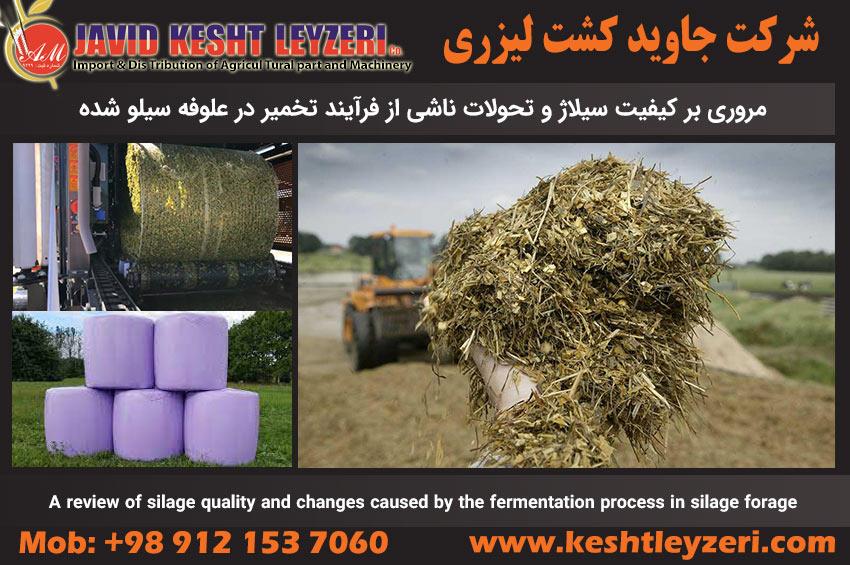اسیدهای چرب فرار محصولات اصلی در فرایند تخمیر مواد سیلویی هستند که بعضی مضر و برخی مفیدند.بطور کلی مهم ترین اسیدهای چرب فرار که در کیفیت یک سیلاژ تأثیرگذار هستند، که در این بخش بررسی می شوند.
برای دریافت اطلاعات در مورد دستگاه بسته بندی علوفه و دستگاه سیلاژ علوفه، قیمت خرید دستگاه بسته بندی علوفه و مشاوره خرید کافی است با مدیر فروش شرکت جناب آقای مهندس مردانی با شماره همراه 09121537060 تماس بگیرید و یا از طریق پیام رسان ایتا و واتساپ به ایشان پیام ارسال نمایید.
اسیدهای چرب فرار محصولات اصلی در فرایند تخمیر مواد سیلویی هستند که بعضی مضر و برخی مفیدند.بطور کلی مهم ترین اسیدهای چرب فرار که در کیفیت یک سیلاژ تأثیرگذار هستند، بدین قرارند:
الف-لاکتیک اسید:
لاکتیک اسید یکی از شاخص های مهم در تشخیص یک تخمیر خوب در فرآیند سیلو به حساب می آید.لاکتیک اسید به تنهایی می بایست تا 70 % مجموع اسیدهای موجود در سیلاژ را به خود اختصاص دهد این مقدار معادل با 4 تا 5 درصد ماده خشک موجود در سیلاژ مطلوب می باشد. علوفه سیلویی مرغوبی که ماده خشک مناسب برای سیلو کردن داشته ، از قندهای محلول بی نصیب نبوده ، روند سیلو کردن آن در شرایط کاملاً بی هوازی انجام گرفته، PH آن دفعتاً و در عرض فقط چند ساعت به زیر 4.5 رسیده، و بالاخره نتیجه تخمیر بی هوازی آن فرایند سرد سیلو می باشد،محصول نهایی ) سیلاژ(کاملاً مرغوب و مطلوب از آن بدست میاید. این فرایند مخصوصاً در کیسه های پلی اتیلن و توسط دستگاههای سیلاژبگر بوقوع می پیوندد که بطور قطع با رشد باکتری های مولد لاکتیک اسید(LAB) همراه بوده و بواسطه این عوامل میزان لاکتیک اسید در محیط سیلو افزایش و به تبع آن کیفیت سیلاژ تولیدی بطور محسوسی ارتقاء پیدا میکند.
ذیلاً مهم ترین گونه های باکتریایی تولید کننده اسید لاکتیک در سیلو را برمی شمریم :
1- Streptococcus (S.faecium)
2- Enterococcus
3- Lactococcus
4- Leuconostoc
5- Pediococcus (P.pentacocus, P.cerevisea)
6- Lactobacillus (L.buchenari, L.acidilacti)
7- Bifidobacterium
8- Plantarium
نکته : در علوفه سیلویی درو شده ، باکتری های تولید کننده اسیدلاکتیک 1000 مرتبه کمتر از رقبای هوازی خود نظیر قارچها و آنتروباکتریا هستند.وقتی شرایط سیلو کردن کاملاً بی هوازی شده و ماده خشک علوفه نیز مطلوب باشد، در آن صورت مجالی برای رشد باکتریهای مضر در سیلو بوجود نیامده و باکتریهای تولید کننده لاکتیک اسید با همین جمعیت کم قادر به رشد و تکثیر خواهند شد.
ب- استیک اسید:
در شرایطی که PH بیشتر از 4.5 باشد در آنصورت آنتروباکتریها رشد و تکثیر نموده و اسید استیک را بوجود می آورند. هم چنین موقعیکه زمان کاهش pH به زیر 4.5 طولانی گردد، در آنصورت مواد مغذی برای تولید سیلاژ مرغوب کاهش یافته و میزان تولید اسید استیک در
محیط سیلو افزایش پیدا می کند.بوی ترشیدگی ، بوی تند سرکه و رنگ زرد (رنگ پریدگی) سیلاژ تولیدی حاکی از میزان استیک اسید بالا در آن است.این خصوصیات وقتی آشکار می شود که مقدار استیک اسید به بیش از 50 % ماده خشک سیلاژ افزایش می یابد. با بالا رفتن مقدار استیک اسید ، مصرف سیلاژ کاهش یافته و طعم آن برای گاو خوشایند نخواهد بود.
با این مشکل چه باید بکنیم ؟
اولاً شرایط سیلو را به گونه ای فراهم آوریم که به این مشکل بر نخوریم.برای اینکار علوفه با درصد ماده خشک مطلوب (برای ذرت علوفه ای حداقل ماده خشک مطلوب 25 % ، برای یونجه پژمرده 28% ، و برای تفاله تر چغندر قند 22 % می باشد) در اختیار داشته و شرایط سیلو نمودن را کاملاً بی هوازی کنیم (بهترین شرایط در کیسه های پلی اتیلن دستگاه های سیلاژبگر بوجود می آید).
چنانچه میزان اسید استیک سیلاژ بالا باشد، آنرا با سیلاژ مرغوب تر مخلوط کرده تا میزان سیلاژ نامرغوب در جیره کاهش یابد.به عبارت دیگر، از سیلاژ تولیدی نامرغوب در جیره کمتر استفاده کنیم.
سیلاژ حاوی اسید استیک زیاد را قبل از مصرف برای یک روز هوا داده و زیررو کنیم.
به جهت خنثی کردن اسید استیک سیلاژی که بوی سرکه می دهد ، از بی کربنات سدیم به نسبت 0.5 تا 1 درصد ماده خشک مصرفی استفاده نماییم.
ج- بوتیریک اسید
بوتیریک اسید توسط چند گونه از کلستریدیوم ها تولید می شود. منشأ اصلی آن خاک و کود حیوانی است .اسپورهای این میکروب ممکن است بر روی علوفه سیلویی نشسته و در شرایطی که سیلو کردن علوفه کاملاً غیرهوازی نیست، رشد و تکثیر آن شروع می شود. مقادیر بالای بوتیریک اسید در سیلاژ (بیشتر از 0.5 درصد ماده خشک) عوارض نامطلوب زیر را به همراه دارد:
* کاهش مصرف سیلاژ توسط دام
* عوارض بهداشتی ناشی از افزایش کتون ها در خون و بروز بیماری کتوز در گاو
* وجود اسید بوتیریک در سیلاژ بوی تند،بوی بادخوردگی و بوی ماهی گندیده را به مشام ما می رساند.
دلایل اصلی بوجود آمدن سطح بالای بوتیریک اسید در سیلاژ،چنانچه گفتیم آلودگی علوفه به خاک و مدفوع حیوان است.افزون بر آن علوفه حاوی مقادیر پایین مواد انرژی زا و نبود قند محلول در محیط و مهم تر از همه رطوبت بیش از حد ذرت علوفه ای (کمتر از 22 % ماده خشک) از عوامل حضور اسید بوتیریک در سیلاژ بعنوان محصول نامطلوب فرایند سیلو شدن علوفه می باشد.
د-الکل اتیلیک (اتانول)
الکل اتیلیک توسط باکتری های باسیلی (با سیلوس ها) و مخمر تولیدکننده الکل بوجود می آید.معمولاً زمانی که سیلو کردن علوفه در تحت شرایط بی هوازی انجام می شود، میزان اتانول از یک تا دو درصد تجاوز نکرده و مشکلی فراهم نمی کند.اما وقتی هوا به درون سیلو نفوذ پیدا میکند،در آنصورت ریسک افزایش کپک توسط میکروبهای باسیلی به شدت افزایش می یابد. پس از گشودن سیلو و مجاورت آن با هوا و در صورتیکه سیلاژ به فاصله زمانی کوتاه به مصرف نرسد،مخمر به سرعت رشد کرده و بخاطر حضور اکسیژن در محیط،سیلاژ تولیدی به سرعت فاسد می شود (تخمیر تانویه سیلاژ در محیط هوازی). استشمام بوی الکل نشانه تخمیر بسیار ضعیف و غیر قابل قبول است.
برای دریافت اطلاعات در مورد دستگاه بسته بندی علوفه و دستگاه سیلاژ علوفه، قیمت خرید دستگاه بسته بندی علوفه و مشاوره خرید کافی است با مدیر فروش شرکت جناب آقای مهندس مردانی با شماره همراه 09121537060 تماس بگیرید و یا از طریق پیام رسان ایتا و واتساپ به ایشان پیام ارسال نمایید.
کلمات کلیدی: قیمت دستگاه سیلاژ علوفه,قیمت دستگاه بسته بندی علوفه,فروش دستگاه سیلاژ علوفه,فروش دستگاه بسته بندی علوفه,خرید دستگاه سیلاژ علوفه,خرید دستگاه بسته بندی علوفه,دستگاه بسته بندی علوفه,دستگاه سیلاژ علوفه,دستگاه سیلاژ ذرت علوفه ای,دستگاه سیلاژ تفاله مالت,دستگاه سیلاژ ذرت,دستگاه بسته بندی ذرت علوفه ای,قیمت دستگاه سیلاژ ذرت علوفه ای,قیمت دستگاه سیلاژ,فروش دستگاه سیلاژ,دستگاه سیلاژ تفاله چغندرقند,دستگاه بسته بندی تفاله چغندرقند ,دستگاه سیلاژ یونجه,قیمت دستگاه سیلاژ یونجه,فروش دستگاه سیلاژ یونجه,قیمت دستگاه سیلاژ مالت علوفه ای,خرید دستگاه سیلاژ یونجه







